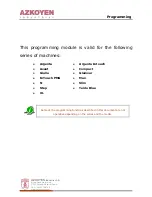
2. On-hook status detection circuit
The on-hook status detection circuit detects the Status of the hook
switch (RHS) of Built-in telephone, and the status of the hook of a
telephone externally connected.
•
The status of on-hook switch (RHS) is determined from the
logical level of RHS signal.
RHS LOW: ON-HOOK
RHS HIGH: OFF-HOOK
•
External telephone hook status detection circuit (HS1)
This circuit comprises the photo-coupler PC1, resistors R3 and
R4, Zener diodes ZD1 and ZD2.
When an external telephone is connected and enters the on-hook
mode, the LED of photo-coupler PC1 emits light and the light
receiving element turns on. The status signal HS1 is input to the
pin 84 of (XFC-MVP) (IC3: control PWB).
HS1 LOW: EXT. TEL OFF-HOOK
HS1 HIGH: EXT. TEL ON-HOOK
3. Dial pulse generation circuit
The pulse dial generation circuit comprises the CML relay.
4. CML relay
The CML relay switches over connection to the matching trans-
former T1 while the FAX or built-in telephone is being used.
5. Matching transformer
The matching transformer performs electrical insulation from the
telephone line and impedance matching for transmitting the
TEL/FAX signal.
6. Hybrid circuit
The hybrid circuit performs 2-wire-to-4-wire conversion using the
IC2 of operational amplifier, transmits the voice transmission sig-
nal to the line, and feeds back the voice signal to the voice recep-
tion circuit as the side tone.
7. Speaker amplifier circuit
The speaker amplifier monitors the line under the on-hook mode,
outputs the buzzer sound generated from the XFC-MVP (IC3:
control PWB), ringer sound, DTMF generated from the modem,
and line sound.
8. Adjustment of voice/ringer volume
The voice/ringer volume can be adjusted by using the panel
bottons "UP" and "DOWN".
•
The ringer volume can be adjusted in the Stand-by mode by
pressing the UP/DOWN button.
•
The reception level can be adjusted by pressing the UP/DOWN
button when the handset is located in the off-hook state.
•
The speaker volume can be adjusted by using the speaker key.
9. Signal selection
The following signals are used to control the transmission line of
TEL/FAX signal. For details, refer to the signal selector matrix
table.
[Control signals from output port]
Signal Name
Description
CML
Line connecting relay and DP generating
relay
H: Line make
L: Line break
SP MUTE
Speaker tone mute control signal
H: Muting (Power down mode)
L: Muting cancel (Normal operation)
TEL MUTE
Handset reception mute control signal
H: Muting
L: Muting cancel
SEL C
Handset receiver volume control signal
(The circuit is located
in the control PWB.)
SIDE KICK is two-stage switching.
Note: The DTMF sending listed above is DTMF signal
sending in the handset OFF-HOOK mode.
VOL A
VOL B
VOL C
(The circuit is located
in the control PWB.)
Speaker volume control signal
SEL A
(The circuit is located
in the control PWB.)
TXOUT mute signal
H: Signal sending, when transmitting
L: During reception, transmission mute,
(during standby)
GAIN-C
(The circuit is located
in the control PWB.)
Reception gain switching signal
L: When connected to line, 1: 1 gain
H: When not connected to line, HIGH gain
TXCONT
(The circuit is located
in the control PWB.)
Transmission/transfer switching signal
H: When transmitting modem signal
(during standby)
L: When transferring
MPX B
(The circuit is located
in the control PWB.)
Receiving F characteristic switching
H: High-frequency cut
L: Straight
Note: Selection when the caller ID is detected.
MPX C
(The circuit is located
in the control PWB.)
Speaker output signal switching
H: Buzzer signal output
L: When monitoring line signal
RXCONT
Modem input signal switching
H: Line signal input
L: Handset microphone input
MONITOR
Line signal monitor switch
H: Line signal monitor
L: Line signal monitor off
Volume
High
Middle
DTMF sending
SEL C
H
L
L
VOL A VOL B VOL C
ON-HOOK
Receiving
RINGER BUZZER
DTMF
ICM/
OGM
X 0
L
L
L
—
—
—
—
High
X 1
H
L
L
High
High
—
—
Middle1
X 2
L
H
L
Middle1
—
—
—
Middle2
X 3
H
H
L
Middle2 Middle
—
High
Middle3
X 4
L
L
H
Middle3
—
Fixed Middle1
—
X 5
H
L
H
—
—
—
Middle2
Low
X 6
L
H
H
Low
Low
—
Middle3
—
X 7
H
H
H
—
—
—
Low
—
FO-1850TH
5 – 10
Содержание FO-1850
Страница 65: ...M E M O FO 1850TH 5 13 ...
Страница 73: ...Control PWB parts layout Top side 6 8 FO 1850TH ...
Страница 74: ...Control PWB parts layout Bottom side 6 9 FO 1850TH ...
Страница 76: ...TEL LIU PWB parts layout 6 11 FO 1850TH ...
Страница 78: ...6 13 Power supply PWB parts layout FO 1850TH ...
Страница 81: ...Operation panel PWB parts layout 6 16 FO 1850TH ...
Страница 83: ...Joint PWB parts layout 6 18 FO 1850TH ...
Страница 96: ...M E M O FO 1850TH 8 9 ...
















































